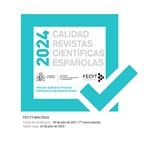Leges de Toro. Construcciones interpretativas e historiográficas. (RI §404734)

Leges de Toro. Interpretative and historiographycal constructions -
Javier García Martín
Las Leyes de Toro (1505), sólo derogadas -y no plenamente- por el Código Civil de 1889, además de regular decisivas instituciones familiares y sucesorias fijaron definitivamente, a través de su temprana edición impresa, el orden teórico en la aplicación judicial de los textos normativos del Derecho castellano. Dictadas con la finalidad de resolver las dudas que esta práctica había suscitado en determinadas materias, el propio carácter de cada una de las nuevas leyes -declarativas y con ello retroactivas o constitutivas y por ello irretroactivas, conforme al ius commune- fue objeto ya de discrepancias en su época a la hora de darles un carácter extensivo o restrictivo por parte de los jueces. Pero además, lo relevante de las materias reguladas y su perduración en el tiempo -al pasar sin modificación a las Recopilaciones castellanas-, las convirtieron pronto en objeto de interpretaciones globales diferentes en función de la cultura jurídica de las sucesivas épocas históricas. En este estudio se analizan seis diferentes interpretaciones: la apegada al ius commune, la ilustrada, la codificadora hasta 1889, la anterior a la guerra civil, la posterior y las orientaciones más recientes. El examen de las diferentes construcciones interpretativas o historiográficas resulta un medio adecuado no sólo para conocer las categorías jurídicas irrenunciables de las que cada época parte, sino para poner de manifiesto la necesidad de abandonar la proyección mecánica al pasado de los conceptos de ley y código.
I. CLAVES CONCEPTUALES: LAS LEGES DE TORO Y EL IUS INTERPRETANDI REGIO: 1. Promulgación, impresión y peculiaridades de su inserción en la Recopilación de 1567 [R].- II. LA LEY TERRITORIAL ESCRITA Y SU RELACIÓN CON LA COSTUMBRE Y EL IUS COMMUNE. LOS COMENTARIOS A LAS LEYES DE TORO DE LOS SIGLOS XVI Y XVII: 1. Flexibilidad interpretativa de la ley I de Toro. 2. Valoración que los juristas de esta época hacen de las Leyes de Toro.- III. LAS LEYES "PATRIAS" FRENTE AL "DERECHO ROMANO". LOS COMENTARIOS EN CASTELLANO A LAS LEYES DE TORO (SS. XVIII-XIX): 1. Valoración de los juristas ilustrados.- IV. EL S. XIX. LAS LEYES DE TORO Y LA BÚSQUEDA DE LA TRADICIÓN JURÍDICA "NACIONAL": 1. Valoración de los juristas liberales.- V. TRAS EL CÓDIGO. LA INTERPRETACIÓN HISTÓRICO-JURÍDICA ¿EMANCIPADA DEL DERECHO CIVIL?.- VI. LA RUPTURA DE LA GUERRA CIVIL. EL CÓDIGO COMO POSITIVIZACIÓN DE LA "TRADICIÓN JURÍDICA ESPAÑOLA" Y SUS CONSECUENCIAS EN LA HISTORIA DEL DERECHO.- VII. REFORMULACIONES Y NUEVAS PERSPECTIVAS DESDE 1978.- VIII. CONCLUSIÓN ABIERTA: LA RELATIVIDAD DE LOS MODELOS JURÍDICO-CULTURALES Y DE LOS CONCEPTOS DE "CÓDIGO" Y "LEY".
The Leyes de Toro (1505) only abolished -but not completely - by the Spanish Civil Code (1889), besides regulating main family and succesor institutions, established definitively, through its early printed edition, the theoretical order of judicial application for the guidelines of Castilian Law. Issued on the purpose to solve the doubts that the previous judicial practice had raised in certain matters, the own character of each of these laws -declarative ones and so retroactive ones or constitutive ones, and because of that not retroactive ones, according to ius commune- was already subject of discrepancies at that time when lawyers were to give them an extensive or restricted character. However besides, the importance of the regulated matters and its duration in time -when they passed without modifications to the Castilian Law Codes of 1567 and 1805- turned them soon in the object of different global interpretation according to the juridical culture of the following historical periods. In this paper, six different interpretations have been analysed: the one linked to ius commune, the Enlightent one, the Codifing movement until 1889, the time before the Spanish civil war, the time after, and the most recent directions. The different interpretative and historiographical approaches become the suitable means not only to get know the unavoidable juridicial categories from each period, but also to make clear the need to leave behind the mechanical projection to the past of concepts like "law" and "code".
I. Conceptual keys: the LEGES of Toro and the IUS interpretandi REGIO. 1.1. Enactment, printing and peculiarities of their insertion in the compilation of 1567 [R]. II. TERRITORIAL LAW WRITTEN AND ITS RELATION WITH THE CUSTOM AND THE IUS COMMUNE. COMMENTS TO THE TORO LAWS ON XVI AND XVII CENTURIES. 2. 1. Flexibility interpretative about Act I of Toro. 2. 2. Assesments that jurists of this era are doing about Toro Laws. III. "HOMELAND" LAWS OPPOSITE TO "ROMAN LAWS". COMMENTS IN CASTILIAN TO THE TORO LAWS (XVIII-XIX CENTURIES). 3.1. Enlightened jurists assessments. IV. XIX CENTURY. TORO LAWS AND THE "NATIONAL" LEGAL TRADITION. SEARCHING. 4.1. Liberal jurists assessments. V. AFTER THE CODE. HISTORICAL-LEGAL INTERPRETATION EMANCIPATED FROM THE CIVIL LAW?. VI. BREAKING-OFF CIVIL WAR. CODE LIKE POSITIVIZATION OF THE "SPANISH LEGAL TRADITION" AND ITS IMPACT ON THE LAW HISTORY. VII. REFORMULATES AND NEW PERPECTIVE SINCE 1978. VIII. OPEN CONCLUSION: THE LEGAL-CULTURAL RELATIVITY MODELS AND CONCEPTS ABOUT "CODE" AND "LAW".
Documento disponible para usuarios registrados.
Para consultar gratuitamente este artículo primero deberá registrarse como usuario.

 DIRECTORA
DIRECTORA